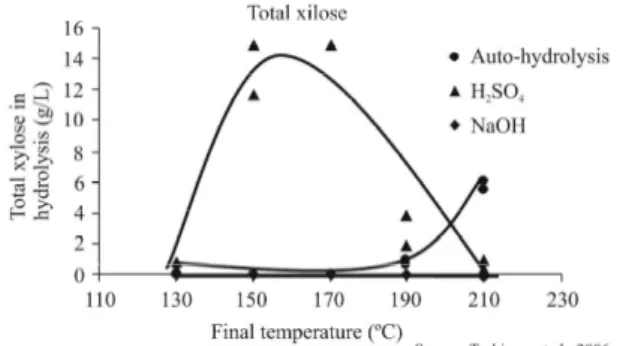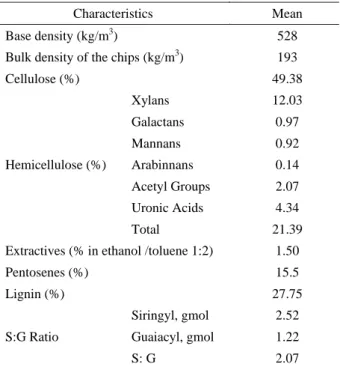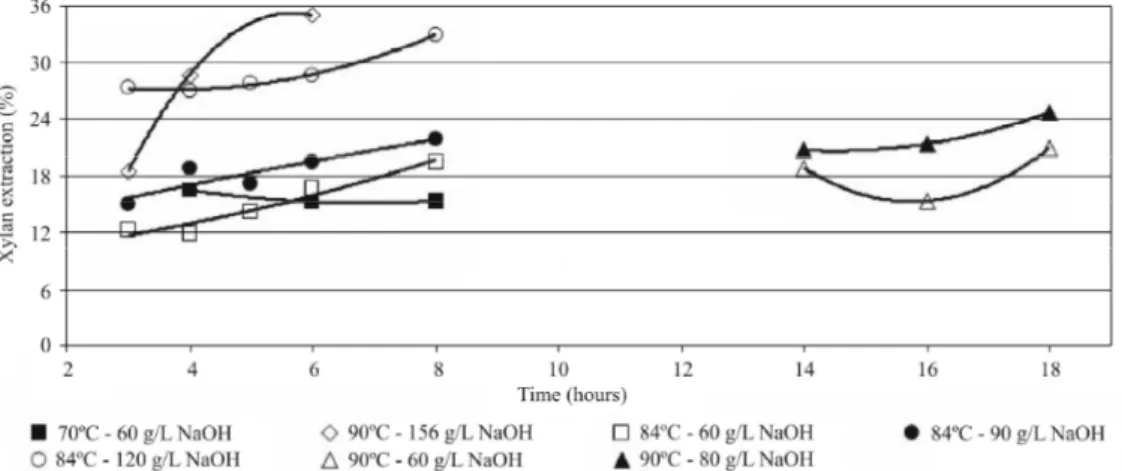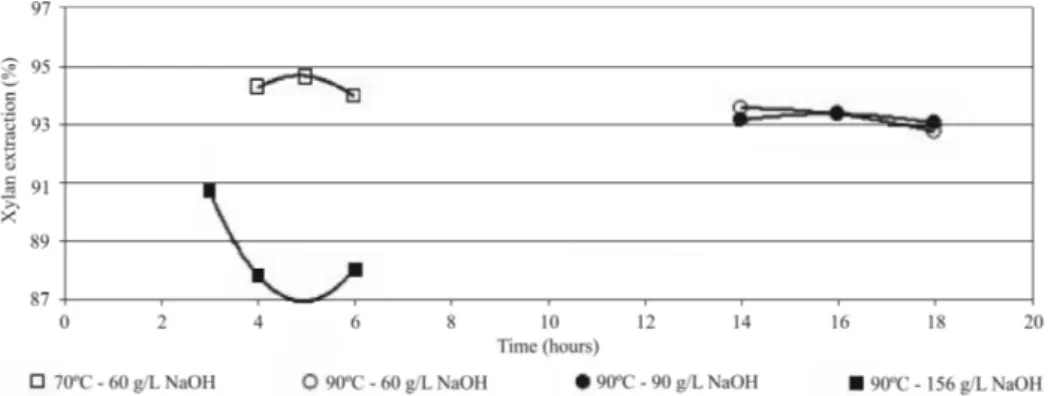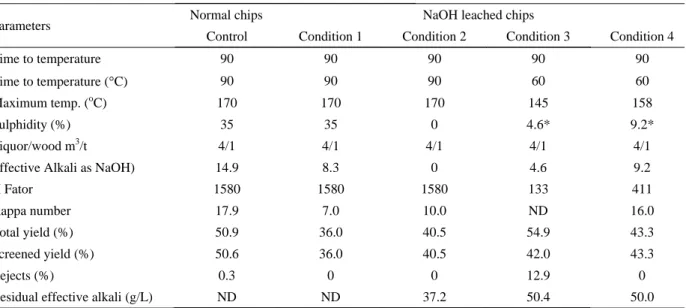Dalton Longue Júnior1, Jorge Luiz Colodette2, Valéria Juste Gomes3 (received: April 30, 2009; accepted: July 29, 2010)
ABSTRACT: The aim of this work was to assess the impact of hemicellulose extraction in eucalyptus wood, through alkaline leaching (NaOH) of wood chips, on the subsequent kraft process (with varying sulphidity) and the quality of the pulp. The chips were initially saturated with water and treated with a NaOH solution in a liquor to wood ratio of 6:1 m3/t. The reaction times (3, 8, 14 and 16 hours), temperatures (70, 84 and 90°C) and NaOH concentrations (60, 80, 90, 120 and 156g/L) were assessed in atmospheric conditions. In the pressurized treatments (300 kPa), the reaction times, temperature and NaOH concentrations assessed were, respectively: 30, 60 and 120 minutes, 100°C and 100, 150 and 200g/L. The optimal alkaline leaching condition was determined taking into account the hemicellulose concentrations remaining in the chips and the gravimetrical yield. Chips not subjected to alkaline treatment (control) and leached with NaOH in optimum conditions were kraft cooked until kappa number 17 – 18. The results indicate that alkaline leaching of chips is not efficient in extracting hemicelluloses in the wood studied. The highest extraction of 4-O-methyl-glucuronoxylan acetate reached 42% in very severe conditions (100°C, 60 minutes, 200g/L of NaOH and 300 kPa pressure). The pulp yield of the leached chips was approximately 7% lower than that of the non-leached chips (control).
Key words: Alkaline leaching, hemicellulose extraction, xylans, yield.
REMOÇÃO DE HEMICELULOSES DA MADEIRA POR TRATAMENTO DE LIXIVIAÇÃO ALCALINA COM NaOH
RESUMO: Neste estudo, objetivou-se avaliar o impacto da remoção de hemiceluloses da madeira de eucalipto, por tratamento de
lixiviação alcalina (NaOH) de cavacos, no comportamento do processo kraft (com variação da sulfidez) subsequente e na qualidade da polpa. Na lixiviação alcalina, os cavacos foram inicialmente saturados com água e posteriormente tratados com solução de NaOH, numa relação licor:madeira de 6:1 m3/t. Foram avaliados os tempos de reação de 3, 8, 14 e 18 horas, as temperaturas de 70, 84 e 90°C e as concentrações de NaOH de 60, 80, 90, 120 e 156g/L sob condições atmosféricas. Para os tratamentos pressurizados (300 kPa), foram investigados os tempos de reação de 30, 60 e 120 minutos, a temperatura de 100°C e as concentrações de 100, 150 e 200g/L de NaOH. A condição ótima de lixiviação alcalina foi determinada, considerando-se os teores de hemiceluloses remanescentes nos cavacos e o rendimento gravimétrico. Cavacos não submetidos ao tratamento alcalino (referência) e lixiviados com NaOH, em condições ótimas, foram cozidos pelo processo kraft até número kappa 17 – 18. Os resultados indicaram que a lixiviação alcalina dos cavacos é ineficiente na remoção das hemiceluloses da madeira estudada. A máxima remoção do acetato de 4-O-metil-glicuronoxilana foi de 42% em condições muito severas (100°C, 60 minutos, 200g/L NaOH e 300 kPa de pressão). O rendimento do cozimento kraft dos cavacos lixiviados foi cerca de 7% inferior ao da referência.
Palavras-chave: Lixiviação alcalina, remoção de hemiceluloses, xilanas, rendimento.
1Forest Engineer, Master of Forest Science – Laboratório de Celulose e Papel – Universidade Federal de Viçosa/UFV – Av. P.H. Rolfs,
s/n – 36570-000 – Viçosa, MG, Brasil – daltonufv@yahoo.com.br
2Forest Engineer, Professor PhD in Forest Science – Laboratório de Celulose e Papel – Universidade Federal de Viçosa/UFV – Av. P.H.
Rolfs, s/n – 36570-000 – Viçosa, MG, Brasil – colodett@ufv.br
3Chemist, Masters Candidate in Agrochemistry – Laboratório de Celulose e Papel – Universidade Federal de Viçosa/UFV – Av. P.H. Rolfs,
s/n – 36570-000 – Viçosa, MG, Brasil – valjusgo@yahoo.com.br
1 INTRODUCTION
The economic efficiency of eucalyptus wood used to produce kraft cellulose may be enhanced through the prior extraction of some of the wood components. In this case, the hemicelluloses are highly penalized during the cooking process and are used in other industrial processes to produce value-added products such as alcohols, xilytol, biopolymers, basic chemical products, etc.
In eucalyptus woods the loss of hemicelluloses during kraft pulping may be considerable (50 – 60%). This
significant hemicellulose loss during pulping is due to many factors inherent to their chemical structure, such as low molecular weight, low crystallinity, ramification of the polymer chains, low stability of the component monomers (xylose, galactose, mannose, arabinose and raminose) and to acetyl groups (SJÖSTROM & ALÉN, 1999).
Hemicellulose concentration in the eucalyptus woods adapted to Brazilian conditions, Eucalyptus grandis and the hybrid Eucalyptus grandis x Eucalyptus
urophylla, is relatively low in comparison to other short
pendula. However, eucalyptus hemicellulose is constituted
mainly by xylans (PASCOAL NETO et al., 2004), which are soluble in water and alkali (SJÖSTRÖM & ALÉN, 1999) and may, therefore, be extracted through simple extraction. The main variables involved in xylan extraction through water and alkali leaching are temperature, time and pH (SINGH, 1979).
Hemicelluloses are usually extracted using sodium or potassium hydroxide. However, an alkaline environment promotes almost complete de-acetylization of hemicellulose chains (FOREST COMISSION, 2006).
During kraft pulping of eucalyptus wood, large quantities of xylans are dissolved and eliminated along with the dark liquor. According to Colodette (2005), hemicellulose losses in Eucalyptus grandi during pulping may reach 62% of their original amount. Therefore, hemicelluloses are the carbohydrates most penalized during pulping and their extraction before cooking, through selective methods, may, theoretically, improve the yield of the kraft process.
Tschirner et al. (2006), studying xylan extraction through hydrolysis, acid hydrolysis and alkaline leaching, found that, in an acid environment (H2SO4 0,01-1,0%p/v) all the xylans were hydrolyzed, while in auto-hydrolysis
(water to wood ratio of 4:1 m3/t) hydrolysis begins at 150°C and in an alkaline environment (NaOH 4% w/w) xylan extraction is low until 170ºC and the fraction removed has a polymer shape (Figure 1).
Figure 1 – Xylan extraction in aspen wood using the treatments: auto-hydrolysis, acid hydrolysis and alkaline leaching.
Figura 1 – Remoção de xilanas da madeira de aspen utilizando
os tratamentos: auto-hidrólise, hidrólise ácida e lixiviação alca-lina.
The main objective of this work was to assess the impact of hemicellulose extraction in eucalyptus wood, through alkaline leaching (NaOH) of chips, on the
subsequent kraft process, as well as to determine the optimal time and temperature conditions for partial hemicellulose extraction in eucalyptus wood chips.
2 MATERIAL AND METHODS
Seven-year old hybrid Eucalyptus grandis x
Eucalyptus urophylla wood chips from forests in Mato
Grosso do Sul state, Brazil, were used. The chips were classified in 32 x 32 mm and 16 x 16 mm screens and the base (hydrostatic method – ABNT NBR 11941) and bulk (TAPPI 258 om-94 adapted) densities were determined. After air drying, the chips were stored in polyethylene bags to standardize and maintain moisture levels. For the cooking analyses, the chips were mixed and part of them was ground in a Willey mill. The sawdust was classified in 40/60 mesh screens, air dried and stored in glass jars.
The flow chart (Figure 2) summarizes the methods applied in this work.
Figure 2 – Sketch of the experiment.
Figura 2 – Esquema experimental do estudo.
2.1 Alkaline leaching of the chips
90%, necessary to transform them into sawdust. The chips were ground in a Willey mill, the sawdust was classified in 40/60 mesh screens and the 2:1 ethanol/toluene extractives (Tappi T204 cm-97) were extracted. A full chemical analysis of the sawdust was done (carbohydrates – HPLC Tappi T 249; uronic acids Sundberg et al. (1996); acetyl groups -Solar et al. (1987)). Pentosenes (Tappi T223 cm-84), lignin (Tappi T222 om-98 and Tappi UM 250) and the siringyl/ guaiacyl lignin ratio (Nitrobenzene oxidation according to Lin and Dence. Methods in Lignin Chemistry. Springer Verlag, 1992) were also assessed.
The analyses were done in the following conditions: in the non-pressurized treatments, reactions times from 3 to 8 and 14 to 18 hours, temperatures of 70, 84 and 90°C and sodium hydroxide concentrations of 60, 80, 90, 120 and 156g/L were assessed. In the pressurized treatments (300 kPa), 30, 60 and 120 minutes reaction times, temperature of 100°C and NaOH concentrations of 100, 150 and 200g/ L were assessed. The NaOH to wood ratio of 6:1 m3/t was constant in all the treatments.
2.2 Kraft cooking of non-leached (control) and NaOH leached chips
The 200 g samples of non-leached (control) and alkali leached chips were kraft cooked in an M&K batch digestor. The digestor is equipped with a heat exchanger and and a direct circulation pump. Temperature and time are controlled by a computer. The cooking parameters are described in Table 1. The effective alkali charge and H factor applied in the cooking process were determined experimentally to obtain a brown pulp with kappa number between 17 and 18.
Table 1 – Kraft cooking conditions – control sample and alkaline leached chips.
Tabela 1 – Condições do cozimento kraft – amostra referência
e cavacos tratados com lixiviação alcalina.
Cooking Conditions – Alkaline Leached Chips
Sulphidity (%) 35
Liquor/wood (m3/t) 4:1
Reaction Temperature (°C) 170
Time until the temperature (min.) 90
Time until the temperature (min.) 90
H Factor 1525
Effective alkali (%) Adjusted for kappa 17 – 18
3 RESULTS AND DISCUSSION
The mean results of the physical and chemical characterization of the wood, in two replications, are shown in Table 2.
Table 2 – Results of the physical and chemical analysis of the wood.
Tabela 2 – Resultados das análises físico-químicas da madeira.
Characteristics Mean
Base density (kg/m3) 528
Bulk density of the chips (kg/m3) 193
Cellulose (%) 49.38
Hemicellulose (%)
Xylans 12.03
Galactans 0.97
Mannans 0.92
Arabinnans 0.14
Acetyl Groups 2.07
Uronic Acids 4.34
Total 21.39
Extractives (% in ethanol /toluene 1:2) 1.50
Pentosenes (%) 15.5
Lignin (%) 27.75
S:G Ratio
Siringyl, gmol 2.52
Guaiacyl, gmol 1.22
S: G 2.07
The base and apparent densities are characteristic of the eucalyptus wood used to produce kraft cellulose in Brazil. Chemical analysis indicates that it is a material with a low concentration of extractives (~1.5 %) given that for the Brazilian eucalyptus clones this figure varies from 1 to 4% (GOMIDE et al., 2005). The total wood hemicellulose concentration found in this work was 21.4%, a result corroborated by Pascoal Neto et al. (2004) in other Eucalyptus
grandis and hybrid Eucalyptus grandis x Eucalyptus urophylla woods. Hemicelluloses are the sum of xylans +
lignin content, approximately 27.8%, which, in other works (GOMIDE et al., 2005) has varied between 27.5 – 31.7%. The 2.07 siringyl/guaiacyl lignin ratio is considered low, as other studies with eucalyptus wood have obtained results between 2.1 and 4.7 (MOKFIENSKI et al., 2003).
3.1 Alkaline leaching of the chips – non-pressurized process
As shown in Figure 3, xylan extraction through alkaline leaching was, in general, inefficient. The best treatment (90°C - 156g/L of NaOH) extracted only 35%.
Figure 3 – Effect of NaOH concentration, reaction time and temperature on xylan extraction in the chips.
Figura 3 – Efeito da concentração de NaOH, do tempo de reação e da temperatura na remoção de xilanas dos cavacos.
Figure 4 – Extraction of 4-O-methyl-gluronoxylan, acetyls, xylans and uronic acids at different intervals and with varying NaOH doses.
Figura 4 – Remoção de acetato de 4-O-metil-glicuronoxilana, acetilas, xilanas e ácidos urônicos utilizando diferentes intervalos de
tempo e diferentes cargas de NaOH.
Figure 5 – Yield of the alkaline leaching treatments.
Figura 5 – Rendimento dos tratamentos de lixiviação alcalina. A more detailed analysis was carried out to determine what happens to the xylan side chains. Figure 4 shows that the wood acetyls are extracted completely. The uronic acids, however, are resistant and only 26% of them were extracted. The xylan skeleton was relatively resistant to leaching and the highest amount extracted was only 32.9% after 8 hours, while extraction of 4-O-methyl-gluronoxylan was of approximately 40% in the same period. Figure 5 shows that NaOH concentration contributes greatly to yield losses as, parallel to xylan extraction, there is also a loss of other wood components (uronic acids). Treatment with a high NaOH concentration (156g/L) led to a 12% reduction of yield, a much higher figure than the total 4-O-methyl-gluronoxylan acetate extracted. Time and temperature did not greatly influence yield.
3.2 Alkaline leaching of the chips – pressurized process
Even when a pressurized system was used, reaction time contributed little to xylan extraction, indicating that the issue of liquor penetration is not critical. In the most extreme condition (100°C, 60 min. and 200g/L), xylan extraction reached 32.2% and acetyl group, uronic acid and total 4-O-methyl-gluronoxylan extraction reached 100%, 50% and 43%, respectively (Figure 6).
3.3 Kraft cooking of alkali leached chips
The chips leached in the severest condition (60 min., 200g/L of NaOH, 100°C and 300 kPa), in which 43% of 4-O-methyl-gluronoxylan acetate was extracted, were cooked in the conventional kraft method (Table 3).
Figure 6 – Percentage of acetyl groups, xylans, uronic acids and 4-O-methyl-gluronoxylan acetate extracted in pressurized alkaline treatments.
Figura 6 – Porcentagem de remoções de grupos acetilas, xilanas, ácidos urônicos e acetato de 4-O-metil-glicuronoxilana pelos
Table 3 – Conditions and results of the cooking of normal and NaOH leached chips.
Tabela 3 – Condições e resultados dos cozimentos de cavacos normais e lixiviados com NaOH.
*Na2S added to the chips after treatment with NaOH to continue cooking, but calculated based on the alkaline liquor at the start of the treatment.
The control chips consumed 14.9% of effective alkali (as NaOH) to reach kappa number 17.9 and presented a total yield of 50.9% with 0.3% of rejects. In the first cooking process of the leached chips (condition 1), the effective alkali charge applied was only 8.3%, without taking into account the NaOH contained in the chips after leaching. The results indicate that an 8.3% charge was excessive, as the kappa number was reduced to 7.0 and the kraft cooking yield was only 36%, not considering losses that occurred during the leaching process. In the second cooking process (condition 2), no alkali charge was applied and cooking was done using only the NaOH retained in the chips during the treatment (zero sulphidity). The result was a red pulp (soda cooking) with kappa number 10 and a yield of only 40.5%. The high H factor (1580) also contributed to this low yield. It is worth mentioning that the dark liquor presented a high residual alkali level (37.2 g/L NaOH), while the recommended levels should remain between 6 - 8g/L. In the third cooking process (condition 3), only the alkali contained in the leached chips was used. However, 4.6% of Na2S was added to the system, constituting a normal kraft process. The H factor decreased drastically to 133 and the result of the cooking process was a pulp difficult to break down with a very high kappa number (which, for this reason, was not determined) and a high reject content.
Once more the dark liquor presented a high alkali residue (50.4g/L NaOH). In the fourth cooking process (condition 4), in which the aim was kappa number 18, the H factor varied again (411), but the effective alkali charge (9.2% of Na2S) was applied only as Na2S. In this process, kappa number 16 was obtained (close to the aim) but the yield was still very low (43.3%), while residual alkali was still high (50.0g/L NaOH). These results demonstrate that, contrary to what was expected, alkaline leaching used to extract hemicellulose from chips before kraft cooking impairs yield. On the other hand, excess alkali in the leached chips makes control of the subsequent kraft process more difficult, especially regarding sulphidity and the H reaction factor.
4 CONCLUSIONS
NaOH leaching of the chips was inefficient in extracting hemicellulose from wood, and the highest extraction of 4-O-methyl-gluronoxylan was 42%.
The most important variable in the leaching process was NaOH concentration; however, excess alkali in the chips made subsequent cooking of the wood more difficult to control.
Leaching of the chips under atmospheric pressure led to similar results as leaching under a pressure of 300kPa.
Parameters Normal chips NaOH leached chips
Control Condition 1 Condition 2 Condition 3 Condition 4
Time to temperature 90 90 90 90 90
Time to temperature ( C) 90 90 90 60 60
Maximum temp. (oC) 170 170 170 145 158
Sulphidity (%) 35 35 0 4.6* 9.2*
Liquor/wood m3/t 4/1 4/1 4/1 4/1 4/1
Effective Alkali as NaOH) 14.9 8.3 0 4.6 9.2
H Fator 1580 1580 1580 133 411
Kappa number 17.9 7.0 10.0 ND 16.0
Total yield (%) 50.9 36.0 40.5 54.9 43.3
Screened yield (%) 50.6 36.0 40.5 42.0 43.3
Rejects (%) 0.3 0 0 12.9 0
Cooking of the alkali leached chips led to significantly lower yields, in relation to cooking of normal chips at a given kappa number.
The alkaline leaching process was not viable for the eucalyptus wood assessed.
5 BIBLIOGRAPHICAL REFERENCES
COLODETTE, J. L. Wood chemistry course. Viçosa, MG: UFV, 2005. 230 p. Apostila.
FOREST COMISSION. Extraction technologies for tree metabolites. Disponível em: <http://www.forestry.gov.uk/>. Acesso em: 25 jan. 2006.
GOMIDE, J. L.; COLODETTE, J. L.; OLIVEIRA, R. C.; SILVA, C. M. Caracterização tecnológica, para produção de celulose, da nova geração de clones de eucalipto do Brasil. Revista Arvore, Viçosa, v. 29, n. 1, p. 129-137, 2005.
MOKFIENSKI, A.; GOMIDE, J. L.; COLODETTE, J. L.; OLIVEIRA, R. C. Importância da densidade e do teor de carboidratos totais da madeira de eucalipto no desempenho da linha de fibra. In: COLÓQUIO INTERNACIONAL SOBRE CELULOSE KRAFT DE EUCALIPTO, 1., 2003, Viçosa, MG. Anais...Viçosa, MG: UFV, 2003. p. 15-38.
PASCOAL NETO, C.; SILVESTRE, A. J. D.; EVTUGUIN, D. V.; FREIRE, C. S. R.; PINTO, P. C. R.; SANTIAGO, A. S.; FARDIM, P.; HOLMBOM, B. Bulk and surface chemical composition of ECF-bleached hardwood kraft pulp fibres: a
comparative study. Nordic Pulp e Paper Research Journal, Stockholm, v. 19, n. 4, p. 513-520, 2004.
SINGH, R. P. The bleaching of pulp. Atlanta: Tappi, 1979. 694 p.
SJÖSTRÖM, E.; ALÉN, R. Analytical methods in wood chemistry, pulping and papermaking. New York: [s.n.], 1999. 316 p.
SOLAR, R.; KACIK, F.; MELCER, I. Simple semi-micro method for the determination of o-acetyl groups in wood and related materials. Nordic Pulp and Paper Research Journal, n. 4, p. 139-141, 1987.
SUNDBERG, A. K.; SUNDBERG, C.; LILLANDT, A.; HOLMBOM, B. Determination of hemicelluloses and pectins in wood and pulp fibers by acid methanolysis and gas chromatography. Nordic Pulp and Paper Research Journal, v. 11, p. 216-220, 1996.
TSCHIRNER, U.; AL-DAJANI, W. W.; JENSEN, T. Pre-extraction of hemicelluloses and subsequent pulping of Aspen Chips. In: CARLTON, W. DENCE MEMORIAL
INTERNATIONAL SYMPOSIUM ON PAST
ACHIEVEMENTS, 1.; FUTURE CHALLENGES IN PULPING AND BLEACHING, 1., 2006, Vancouver. Proceedings… Vancouver: ESPRA, 2006.
